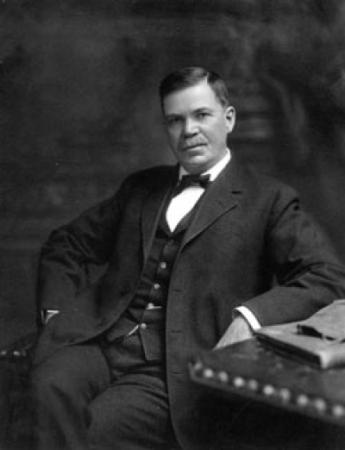Henry Frawley
Henry Frawley
March 13, 1851 - 1927
The gold rush of 1876 brought thousands of miners, muleskinners and madams to Deadwood Gulch, but it also attracted a number of professional men. A wagon train that rolled in on the Fourth of July, 1877, is more than ample proof. Two of the men in that party - John Hunter and W.E. Adams - went on to become successful merchants and wholesalers. Another became known as one of the best lawyers in Dakota Territory.
This third man was Henry Frawley. Born to Irish parents who had immigrated to New York, Henry received his education from the University of Wisconsin in Eau Clair. He received his law degree in 1876 and began practicing in Wisconsin immediately afterward. A year later, however, he was bound for the Black Hills. Although he practiced law independently for a time, shortly after the Great Fire of 1879 Henry formed a partnership with Edward L. Kohen. The firm of Frawley and Kohen went on until 1881. After a few years of once again working alone, Frawley became associated with fellow lawyer John P. Laffey in 1886.
In 1890 Frawley became resident attorney for the Burlington and Missouri Railroad, which built the rail line from Deadwood to Edgemont. On July 22 of that year, Henry married Cristina Anderson, heiress to a ranch in the Centennial Valley north of Deadwood. Two years later Henry established his own ranch in the Centennial Valley. The Frawley Ranch, which eventually grew to encompass more than 3,000 acres, was noted for breeding Belgian and Percheron draft horses and for its unique horned Hereford cattle.
In 1894 Henry's brother James joined his Deadwood law firm, but by 1896 James had left Deadwood for Nome, Alaska. A second brother - Edward - came to work with Henry in 1903, when the practice became known as Frawley and Frawley. Over the next two decades the Frawleys came to represent the Golden Reward Consolidated Gold Mining Company, the American National Bank and the Hidden Fortune Gold Mining Company, among other mining interests.
Aside from becoming known as one of the most successful trial lawyers in the region, Henry was also said to be among the best-read men in the state. His law and private libraries were extensive and contained carefully selected collections. His ranch was among the best improved in the area, boasting stone barns, a private schoolhouse and lavishly furnished residences. Most of these structures still stand on the Frawley property today. His descendents still live in the northern Black Hills.

